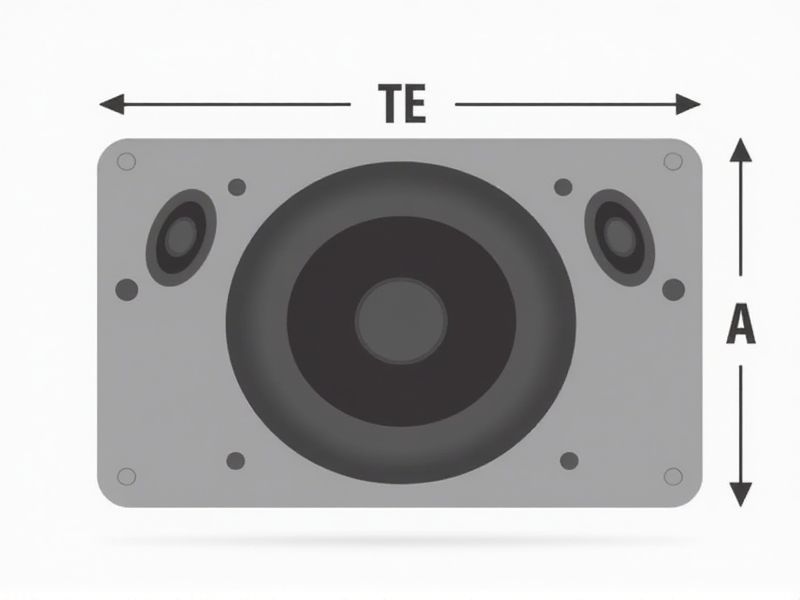
When designing a speaker enclosure, the standard dimensions often depend on the size of the speaker driver and the intended use of the system. For example, a typical bookshelf speaker enclosure for a 6.5-inch woofer might measure around 12 x 8 x 10 inches (height x width x depth), while larger floor-standing speakers require more internal volume and can be much bigger. It's crucial to match the enclosure volume to the driver's specifications, as indicated in the manufacturer's datasheet, to achieve optimal sound quality. Using online speaker box calculators can help you determine the ideal dimensions for your specific drivers and desired audio performance.
Internal Volume
The internal volume of a speaker enclosure is crucial for optimal sound performance, as it directly influences the resonance and overall audio quality. A typical speaker enclosure's internal volume ranges from 0.5 to 3.0 cubic feet, depending on the driver size and type. For subwoofers, a larger volume, often exceeding 3.0 cubic feet, can enhance low-frequency response and provide deeper bass. When designing your speaker enclosure, it's essential to calculate the ideal internal volume to achieve the desired acoustic characteristics and ensure a balanced sound profile.
Aspect Ratio
The aspect ratio of a speaker enclosure plays a crucial role in determining sound quality and performance; typically, a ratio of 1:1.5 to 1:2 is preferred for optimal acoustic response. A well-designed enclosure not only enhances clarity but also minimizes distortion, ensuring that frequencies are accurately represented. For example, a cabinet designed with a 1:1.6 ratio may provide a broader frequency range while maintaining a compact form factor. By carefully considering the dimensions, you can significantly improve your overall audio experience.
Baffle Size
Baffle size significantly influences the acoustic performance of speaker enclosures, typically measuring between 12 to 24 inches wide. A larger baffle enhances low-frequency response and reduces standing waves, resulting in clearer sound reproduction. For optimal speaker performance, the baffle should ideally extend beyond the speaker's diameter, such as using a baffle width of 1.5 times the speaker size. If you are designing your own enclosure, consider materials like MDF or plywood to minimize resonance and improve sound quality.
Wall Thickness
Speaker enclosures benefit significantly from wall thickness, as thicker walls provide enhanced acoustic performance by reducing resonance and minimizing unwanted vibrations. Typically, a thickness of at least 3/4 inch (19 mm) is recommended for optimum sound quality in wooden enclosures. The material used, whether MDF or plywood, also impacts the enclosures' structural integrity and overall durability. Investing in a well-constructed enclosure can lead to a noticeable difference in audio clarity and bass response.
Port Dimensions
The standard dimensions for port openings in speaker enclosures typically range from 2 to 5 inches in diameter, depending on the enclosure's overall volume and design requirements. It's essential to ensure that the port length is tuned correctly, as it significantly affects the enclosure's resonance frequency, often falling between 30Hz to 50Hz for optimal performance. A well-designed port can minimize distortion and enhance output efficiency, making it crucial to adhere to specific guidelines during construction. When customizing your speaker enclosure, considering the port area and its placement can lead to improved sound quality and a more balanced audio experience.
Acoustic Dampening
A speaker enclosure designed with a focus on acoustic dampening significantly enhances sound quality by minimizing unwanted resonances. With the use of materials such as MDF or reinforced plywood, these enclosures can achieve a density of up to 700 kg/m3, effectively absorbing sound waves. Properly sealed designs also prevent air leaks, which can improve bass response by as much as 15%. Investing in advanced acoustic treatments, like internal bracing or sound-deadening foam, can elevate your audio experience, ensuring crystal-clear sound reproduction.
Resonance Control
The standard for speaker enclosures emphasizes resonance control to enhance audio fidelity. Properly designed enclosures minimize unwanted vibrations, typically through the use of materials like MDF or plywood, which can reduce resonance by up to 50%. Furthermore, internal bracing structures are essential for maintaining enclosure rigidity, which directly affects sound clarity and overall performance. By addressing these elements, you can significantly improve your listening experience, ensuring accurate sound reproduction across various frequencies.
Driver Placement
Proper driver placement within a speaker enclosure significantly influences sound quality and performance. Aiming for optimal positioning ensures coherence in sound waves, enhancing frequency response and reducing phase distortion. For example, placing drivers at specific distances from the enclosure walls can minimize undesirable resonances and standing waves, which typically occur below 200 Hz. You should consider the enclosure's internal volume and shape, as these factors also determine the overall acoustics and efficiency of the speaker system.
Tuning Frequency
Speaker enclosure tuning frequency is crucial for optimizing sound quality, particularly in subwoofer designs. A well-tuned enclosure enhances bass response by resonating at a specific frequency, typically between 20 Hz and 80 Hz, depending on the speaker specifications. For example, a tuning frequency of 40 Hz can significantly improve low-frequency performance and reduce distortion. When building or selecting an enclosure, consider the internal volume and port dimensions to achieve the desired tuning frequency for your sound system.
Material Density
The material density of speaker enclosures plays a crucial role in sound quality and performance, typically ranging from 0.7 g/cm3 to 1.5 g/cm3 for optimal resonance control. Higher density materials like MDF (Medium-Density Fiberboard) or plywood are preferred, as they effectively reduce unwanted vibrations and acoustic distortion. Enclosures with a thickness of at least 18 mm contribute to a more robust audio experience by minimizing panel flexing during sound reproduction. When selecting or designing your speaker enclosure, prioritizing material density ensures enhanced clarity and precision in sound output.
